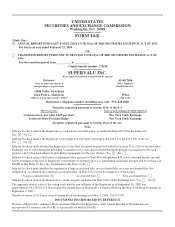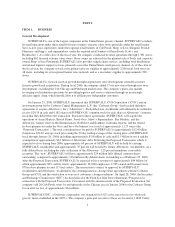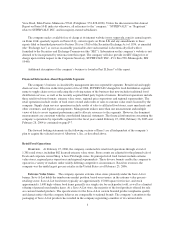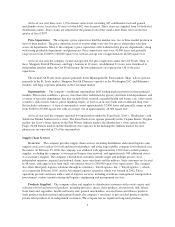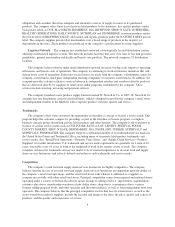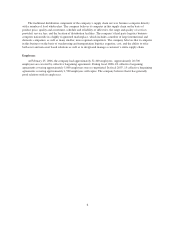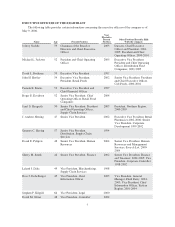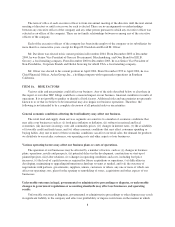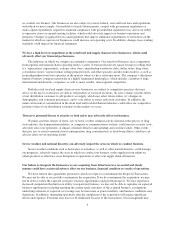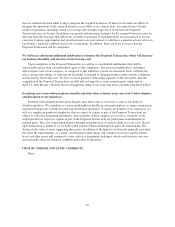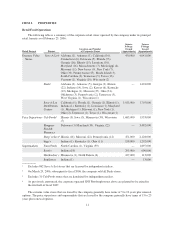Albertsons 2006 Annual Report Download - page 4
Download and view the complete annual report
Please find page 4 of the 2006 Albertsons annual report below. You can navigate through the pages in the report by either clicking on the pages listed below, or by using the keyword search tool below to find specific information within the annual report.At fiscal year end, there were 1,154 extreme value stores, including 445 combination food and general
merchandise stores, located in 39 states of which 862 were licensed. These stores are supplied from 16 dedicated
distribution centers. Store counts are adjusted for the planned sale of the stand-a-lone Deals stores in the first
quarter of fiscal 2007.
Price Superstores. The company’s price superstores hold the number one, two or three market position in
most of their markets. The price superstore focus is on providing every day low prices and product selection
across all departments. Most of the company’s price superstores offer traditional dry grocery departments, along
with strong perishable departments and pharmacies. Price superstores carry over 41,000 items and generally
range in size from 45,000 to 100,000 square feet, with an average size of approximately 64,000 square feet.
At fiscal year end, the company owned and operated 163 price superstores under the Cub Foods, Shop ’n
Save, Shoppers Food & Pharmacy and bigg’s banners in 12 states; an additional 31 stores were franchised to
independent retailers under the Cub Foods banner. In-store pharmacies are operated in 156 of the price
superstores.
The owned Cub Foods stores operate primarily in the Minneapolis/St. Paul markets; Shop ’n Save operates
primarily in the St. Louis market; Shoppers Food & Pharmacy operates in the Washington D.C. and Baltimore
markets; and bigg’s operates primarily in the Cincinnati market.
Supermarkets. The company’s traditional supermarkets hold leading market positions in their principal
markets. This format combines a grocery store that offers traditional dry grocery and fresh food departments, and
a variety of specialty departments that may include floral, seafood, expanded health and beauty care, video rental,
cosmetics, delicatessen, bakery, photo finishing, liquor, as well as an in-store bank and a traditional drug store
that includes a pharmacy. A typical supermarket carries approximately 32,000 items and generally ranges in size
from 30,000 to 65,000 square feet with an average size of approximately 48,000 square feet.
At fiscal year end, the company operated 64 supermarkets under the Farm Fresh, Scott’s, Hornbacher’s and
Sunflower Market banners in five states. The Farm Fresh stores operate primarily in the Virginia Beach, Virginia
market; the Scott’s stores operate in the Fort Wayne, Indiana market; the Hornbacher’s stores operate in the
Fargo, North Dakota market and the Sunflower store operates in the Indianapolis, Indiana market. In-store
pharmacies are operated in 33 of the supermarkets.
Supply Chain Services
Overview. The company provides supply chain services, including distribution and related logistics and
support services to retailers for food and non-food products and is the largest public company food wholesaler in
the nation. At February 25, 2006, the company was affiliated with approximately 2,200 stores as their primary
supplier, excluding the company’s own regional banner store network, and approximately 500 additional stores
as a secondary supplier. The company’s distribution customers include single and multiple grocery store
independent operators, regional and national chains, mass merchants and the military. Such customers are located
in 48 states, and range in size from small convenience stores to 200,000 square foot supercenters. The company
also offers third party logistics solutions through its subsidiary, Total Logistics, Inc. (“Total Logistics”), which
was acquired in February 2005, and its Advantage Logistics operation, which was formed in 2002. These
operations provide customers with a suite of logistics services, including warehouse management, transportation,
procurement, contract manufacturing and logistics engineering and management services.
Products Supplied. The company offers and supplies its distribution customers with a wide variety and
selection of food and non-food products, including groceries, meats, dairy products, frozen foods, deli, bakery,
fresh fruits and vegetables, health and beauty aids, general merchandise, seasonal items and tobacco products.
Such products include national and regional brands, the company’s own lines of private label products and the
private label products of its independent customers. The company has no significant long-term purchase
4

